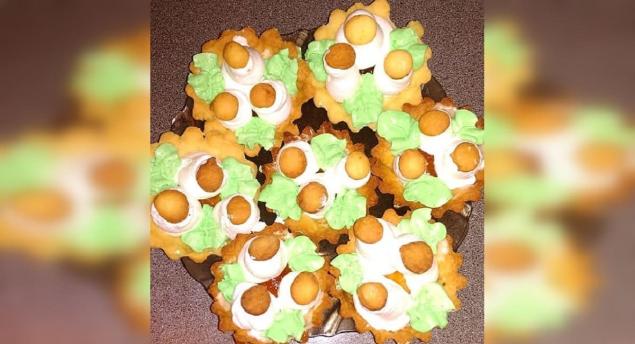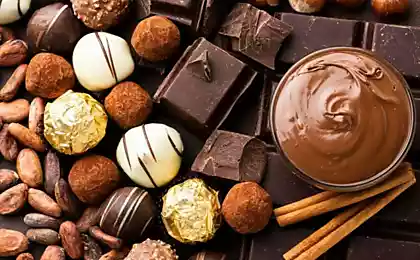131
Soviet sweets, which were so popular then, but now we prefer to bypass them
The inhabitants of the USSR were always slim and fit, with strong white teeth and good skin. But these same people in childhood chewed tar, chewed dry jelly and feasted on sweets with a horse dose of sugar. Often purchased desserts were hard as stone, as if echoing the Soviet covenant to test the spirit and body. What only "Bear in the North" was worth. Remember that?

GettyImages Store treats were quite diverse. Overseas oranges, bananas and tangerines appeared on the shelves only in season. To get good chocolate candies, contrary to the myths of crazy scarcity, it was possible not only for the New Year. However, for this it was necessary to stand in long lines.
Editorial "Site" She made a selection of nostalgic Soviet goodies, which became a test for our teeth and stomachs, but are still as beloved as they were in childhood.
"Bear in the North" "Grillage" was prepared from crushed nuts and syrup from sugar and molasses. The frozen oriental delicacy became very hard and crispy. While the youth famously gnawed caramel-nut sweetness, the adult generation guarded their teeth and gradually dissolved or soaked candy in tea.

Instagram “Grillage” was released in beautiful bright wrappers, so it was proudly offered to guests. For those who failed in the fight with stone candy, free Soviet dentistry was always on the pick-up.
Sunflower halva is an oriental sweet, which also occupied a special place in the dessert vases of the USSR families. It was produced in cardboard and round tin packages (the latter often stored buttons and threads).

Sweet, delicate halva with a rich taste of seeds was produced without a gram of flavor enhancers and flavorings. This dessert is rich in fiber, beauty vitamins A, E, B, D, PP, but very high-calorie - as much as 512 kcal per 100 grams. However, Soviet citizens delighted in weaving him at a festive tea party and were not afraid to get fat. Excess calories went without a remainder in sports, work, amateurism and study.
Candy "Cancer necks" with nutty-caramel filling was invented before the October Revolution and served for dessert to the emperors. The name of the delicacy was given because of the similarity of its shape with the tail of the cancer.
The sweetness was prepared from a mixture of vanilla, sugar, almonds and colorless maraschino cherry liqueur, and then covered with a transparent glaze of potato molasses. Confectioners added crystallized sediment from wine barrels to the composition of the candy so that it did not sugar. The finished delicacy was revealed with a nutty-cherry taste, it crunched pleasantly and ... mercilessly stuck to the teeth and spoiled the fillings.

The sister of "Cancer necks" by a strange name, caramel with nut paste "Crow's feet" appeared even earlier - in the XIX century. How exactly the funny name arose, no one knows exactly, so choose the option to taste. It is assumed that the composition of the candy included a natural thickener - goose fat. According to another version, the sweet was originally a “pharmacy” and contained goose weed to treat the throat.
Delicious sticky and viscous toffees adored everything, from small to large. Soft candy "Buratino" was most loved by grandparents and toddlers. Another thing is the famous testers of seals for strength - "Golden Key", "Fun" "Kis-kiss", "Prima" and "Icebreaker".

They stuck firmly in the jaw and often helped the younger guys to part with their baby teeth faster. After lying down a little, the candies were stoned and could not only damage the enamel, but even break a tooth.
Although the multicolored pea dragee contained only sugar, it was so great to fill your mouth with small bright pebbles or bite them one by one! Different in color, sweet peas did not differ from each other in taste, were very hard and dispersed like seeds - until you eat the whole fist or abdominal pain, you will not calm down.

The cake "Basket" - the legendary delicacy had a gentle sand dough, saw a whole "garden" of cream flowers, leaves, berries, mushrooms and other delights of confectionery fantasy.

He was loved for his taste and appetizing look, but not for the benefit. All the decor was prepared from margarine, added a lot of sugar and dyes. Excess sweet, fatty oil cream increased the load on the liver and damaged the teeth. The “basket” did not eat every day and did not suffer from obesity.
The sweetest memories of the USSR are often associated with a marshmallow in chocolate glaze, which was a scarce dessert. What Soviet child did not dream of finding a box of marshmallow in chocolate under a tree! It was rarely “thrown away” in pastry shops, because it was considered a great luck to get such a treasure.

A lush, gentle delicacy without bubbles was approved by nutritionists for low calorie and useful apple pectin in the composition. To taste better, first it was supposed to chew the chocolate layer, and then proceed to the marshmallow itself.
Lollipops "Montpasier" - transparent multi-colored lollipops produced in two forms: thin curved 2-layer plates with the taste of orange and lemon, as well as slightly flattened balls, which often stick together in one lump. Round "Monpasier" was produced with cherry, kizyl and tangerine-orange taste.

The composition was as simple as possible: citric acid, molasses, sugar, food coloring and natural fruit essence. Bright flat tin boxes skillful Soviet guys and their parents turned into boxes for various necessary home trifles - buttons, buttons, needles, nails, pins and other "treasures".
Sweets with character, aren't they? Although not the most useful, they remind us of the beautiful times of our youth.
And what desserts of the Soviet era do you still remember with special warmth? Share with us in the comments!
Photo in article

GettyImages Store treats were quite diverse. Overseas oranges, bananas and tangerines appeared on the shelves only in season. To get good chocolate candies, contrary to the myths of crazy scarcity, it was possible not only for the New Year. However, for this it was necessary to stand in long lines.
Editorial "Site" She made a selection of nostalgic Soviet goodies, which became a test for our teeth and stomachs, but are still as beloved as they were in childhood.
"Bear in the North" "Grillage" was prepared from crushed nuts and syrup from sugar and molasses. The frozen oriental delicacy became very hard and crispy. While the youth famously gnawed caramel-nut sweetness, the adult generation guarded their teeth and gradually dissolved or soaked candy in tea.

Instagram “Grillage” was released in beautiful bright wrappers, so it was proudly offered to guests. For those who failed in the fight with stone candy, free Soviet dentistry was always on the pick-up.
Sunflower halva is an oriental sweet, which also occupied a special place in the dessert vases of the USSR families. It was produced in cardboard and round tin packages (the latter often stored buttons and threads).

Sweet, delicate halva with a rich taste of seeds was produced without a gram of flavor enhancers and flavorings. This dessert is rich in fiber, beauty vitamins A, E, B, D, PP, but very high-calorie - as much as 512 kcal per 100 grams. However, Soviet citizens delighted in weaving him at a festive tea party and were not afraid to get fat. Excess calories went without a remainder in sports, work, amateurism and study.
Candy "Cancer necks" with nutty-caramel filling was invented before the October Revolution and served for dessert to the emperors. The name of the delicacy was given because of the similarity of its shape with the tail of the cancer.
The sweetness was prepared from a mixture of vanilla, sugar, almonds and colorless maraschino cherry liqueur, and then covered with a transparent glaze of potato molasses. Confectioners added crystallized sediment from wine barrels to the composition of the candy so that it did not sugar. The finished delicacy was revealed with a nutty-cherry taste, it crunched pleasantly and ... mercilessly stuck to the teeth and spoiled the fillings.

The sister of "Cancer necks" by a strange name, caramel with nut paste "Crow's feet" appeared even earlier - in the XIX century. How exactly the funny name arose, no one knows exactly, so choose the option to taste. It is assumed that the composition of the candy included a natural thickener - goose fat. According to another version, the sweet was originally a “pharmacy” and contained goose weed to treat the throat.
Delicious sticky and viscous toffees adored everything, from small to large. Soft candy "Buratino" was most loved by grandparents and toddlers. Another thing is the famous testers of seals for strength - "Golden Key", "Fun" "Kis-kiss", "Prima" and "Icebreaker".

They stuck firmly in the jaw and often helped the younger guys to part with their baby teeth faster. After lying down a little, the candies were stoned and could not only damage the enamel, but even break a tooth.
Although the multicolored pea dragee contained only sugar, it was so great to fill your mouth with small bright pebbles or bite them one by one! Different in color, sweet peas did not differ from each other in taste, were very hard and dispersed like seeds - until you eat the whole fist or abdominal pain, you will not calm down.

The cake "Basket" - the legendary delicacy had a gentle sand dough, saw a whole "garden" of cream flowers, leaves, berries, mushrooms and other delights of confectionery fantasy.

He was loved for his taste and appetizing look, but not for the benefit. All the decor was prepared from margarine, added a lot of sugar and dyes. Excess sweet, fatty oil cream increased the load on the liver and damaged the teeth. The “basket” did not eat every day and did not suffer from obesity.
The sweetest memories of the USSR are often associated with a marshmallow in chocolate glaze, which was a scarce dessert. What Soviet child did not dream of finding a box of marshmallow in chocolate under a tree! It was rarely “thrown away” in pastry shops, because it was considered a great luck to get such a treasure.

A lush, gentle delicacy without bubbles was approved by nutritionists for low calorie and useful apple pectin in the composition. To taste better, first it was supposed to chew the chocolate layer, and then proceed to the marshmallow itself.
Lollipops "Montpasier" - transparent multi-colored lollipops produced in two forms: thin curved 2-layer plates with the taste of orange and lemon, as well as slightly flattened balls, which often stick together in one lump. Round "Monpasier" was produced with cherry, kizyl and tangerine-orange taste.

The composition was as simple as possible: citric acid, molasses, sugar, food coloring and natural fruit essence. Bright flat tin boxes skillful Soviet guys and their parents turned into boxes for various necessary home trifles - buttons, buttons, needles, nails, pins and other "treasures".
Sweets with character, aren't they? Although not the most useful, they remind us of the beautiful times of our youth.
And what desserts of the Soviet era do you still remember with special warmth? Share with us in the comments!
Photo in article
I noticed that children who come to our store, constantly licking glass windows, decided to deal with it in their own way.
Moms from TikTok have figured out how to relax on the beach with young children, and we intend to take their advice























